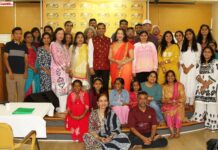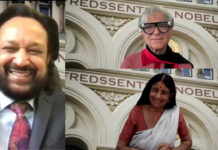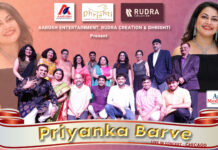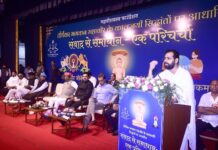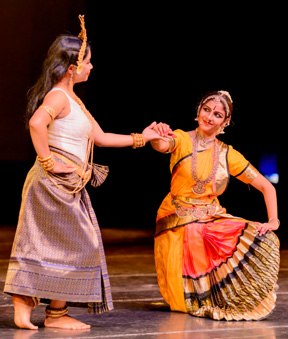 SAN JOSE: Cultural dance traditions preserved for centuries bind people from that land. When that land and its culture is threatened during political strife, it is that much harder for proponents of dance to persevere and preserve their heritage and reclaim it for future generations. Cambodian classical dance, also known as court ballet is one such precious art form that, despite the destruction wrought by Khmer Rouge between 1975 and 1979, was brought back due to relentless pursuits by true devotees of this dance form.
SAN JOSE: Cultural dance traditions preserved for centuries bind people from that land. When that land and its culture is threatened during political strife, it is that much harder for proponents of dance to persevere and preserve their heritage and reclaim it for future generations. Cambodian classical dance, also known as court ballet is one such precious art form that, despite the destruction wrought by Khmer Rouge between 1975 and 1979, was brought back due to relentless pursuits by true devotees of this dance form.
Sangam Arts, a Silicon Valley non-profit organization co-founded by Usha Srinivasan, enlivened our understanding of this art form at the Mexican Heritage Plaza in San Jose. The presentation was a dual winner, as the stage was also shared by the highly acclaimed Bharatnatyam dancer from India, Lavanya Ananth exhibiting her expertise.
Charya Burt, a master teacher, dancer and choreographer presented the traditional Cambodian dance and served literally as the country’s cultural ambassador, although she, herself is now based in California. The simple, yet profound movements evoked a deeply religious and reverential mood, as the dancer, in her first piece, “Of spirits entwined” sought the blessings of spirits and past dance masters through offerings of fruits, incense and flowers.
The dancer gracefully and slowly gyrated and moved fluidly with elaborate wrist and finger flexions and toes flexed upwards with bent knees: salient techniques that demand flexibility, precision and controlled movements executed in slow, long and repetitive patterns. The piece was accompanied by live singing and spoken word, as the masked dancer performed the rituals in a simple white garb…a symbol of purity, before removing the mask and donning jewels and a richer garb to present herself as a dancer.
Charya’s second piece was reflective of her personal journey into the Western world, and the accompanying isolation felt during such shifts. This exploration was accompanied by three types of music -poem, a piece with drums, and finally a jazz version, which symbolized the transformation into her new home. The use of white fans as props symbolized the harmony maintained between the two cultures.
Some of the symbolism, and recited words were lost to the audience due to the language barrier, and a translated version simultaneously presented in the background would have deepened the understanding and enjoyment of the pieces. Overtures of other Eastern influences such as those of Chinese music could be detected based on my limited understanding of the verses offered by Charya.
The aesthetically and emotively rendered Bharatnatyam performances by Lavanya Ananth were a crowd pleaser, especially as she took the time to walk the audience through some of the more established mudras, abhinaya and natya components that comprise this Indian classical dance form. Lavanya performed four distinct pieces, each demonstrating a different aspect of her art, while remaining united in celebrating a spiritual journey through dance.
The four pieces collectively presented under the umbrella of “Seeking the Divine”, began with her expression of the “Ardhanarishwar” avatar of Lord Shiva, representing the Shiv and Shakti, the Prakriti and Purusha. Lavanya effortlessly displayed the quick changes between the male and female forms in this dance. She continued with ” Jagadhodharana” where abhinaya was the dominant facet, as she characterized Yashoda’s infinite love for her divine son, Krishna, without the realization of his true being, and treating him like a mere mortal.
The third piece titled, “Yarukagilum Bhayam” portrays a confident heroine’s response to gossipers on her relationship with the king. The last piece was “Soorya”, which recounts the power of the celestial emperor Surya charioted by his seven horses as he reigns the day. The energy of the ruler of the nine planets also awakens the seven chakras in the body and the spiritual light of knowledge. Lavanya’s expressive rendition of all pieces was pure delight and showed her mastery on all techniques demanded in this classical dance form.
The show stealer was the finale of the dance duet, which I thought of as being similar to a jugalbandi between two artists communicating through their different styles and mediums. Here, the medium was dance, however, the similarities and differences were developed further, as each artist sought to demonstrate the key techniques and expressions that anchor their individual traditions and styles.
Another endearing component of the evening was the “Artists in Conversation” where each discussed their respective dance traditions, and invited the other to compare and contrast the art forms including demonstrations. This greatly enhanced and engaged audience understanding and enjoyment of both forms of dances.
The theme of devotion united the dance forms, their expressions brought out the uniqueness. It was interesting to note that while the Bharatnatyam dancers can portray any character through the use of abhinaya and mudras, Cambodian dancers can only depict the character they are dressed for.
There being only four main characters in Cambodian dance… the princess played by Charya, it seems there might be limits to what the dancers can present. She also mentioned that the character of the giant must only be played by a man, presumably due to larger stature.
Indeed a contrast to Indian dance traditions where several female roles were played by men in earlier times. Another interesting observation was the Cambodian dancer assuming their dance personas after ritual offerings to the spirits on stage, by transforming themselves from the simpler dress and adornments to the character being portrayed. Charya became the princess by shedding the outer white garment, the mask and donning jewels.
It is always a delight to attend Sangam Art presentations as they tend to innovate in their selections. What may have seemed just another dance performance turned out to be an exquisite and pleasurable evening of learning about the intricacies of different cultures and their evolution through dance.
Archana Asthana

